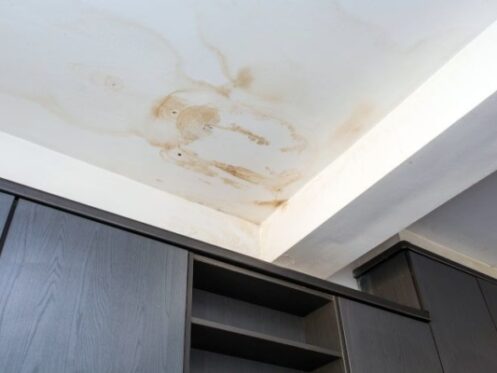The last thing you want to happen on a hot summer day is to have your AC conk out. So when you see liquid collecting or dripping below your HVAC system, your first thought might be, “Why is my AC leaking?” After that, you enter “yikes-is-something-the-matter?” mode.
We’ll deliver the bad news first. Sometimes, a leaking air conditioner is a sign of an AC problem. The system may need to be adjusted or repaired. The good news is that the problem is usually pretty simple to fix. In some cases, it might only look like you have a leak when in reality you don’t!
Let’s consider a few reasons your AC might be leaking. After you’ve got a better understanding of where and why the AC is producing moisture, you’ll know whether it’s time to call for service.
1. See water dripping from a pipe outside? Your AC isn’t leaking.
When your air conditioner is operating properly, you will see water dripping from a pipe outside. This pipe is often located somewhere near the outdoor AC unit. In some homes, there may even be a secondary drain line. These are often used in attic installations, so you might see water dripping from a soffit down the side of the house.
Either way, you’re good. The AC is just doing its job.
You see, your air conditioner has two jobs: remove heat and remove humidity. When it’s running, it’s extracting humidity from the air. That humidity forms condensation on the system’s evaporator coil, which is housed inside the indoor part of your AC. The condensation ultimately drips down into a pan. From there, the condensation (it’s flowing water at this point) enters a small PVC pipe and flows out of your home.
Most of these PVC pipes, aka drain lines, rely on gravity. The water just drips out gradually. In some cases, however, a home might have a condensate pump. If you have one of these, the water may get pumped out in large bursts. Either way, water coming out of the pipe means the system is removing humidity as it should.
If this is the sort of “leak” you’re concerned about, it’s not a leak.
You can go back inside and enjoy your cool, comfortable house. No need to worry about leaks!
2. Airflow restrictions can lead to a leaking AC
So, what if you see water leaking through your ceiling and notice it’s coming from the AC unit in the attic? Or what if you notice a water leak from the AC inside your crawlspace? Well, then you could have a bigger problem.
When this is the sort of thing you’re dealing with, ask yourself: Have I changed my air filter lately? If the answer is no, go check it. It’s probably really dirty!
Failing to change your air filter on a regular basis can restrict airflow through the system. When this happens, the refrigerant inside the AC coil gets too cold and the condensation freezes on the coil. If the ice melts all at once, it could overwhelm the drain line and cause a leak.
So, you should just change your filter, right? Well… maybe. You might also have an issue with your ductwork.
Say you’ve got a leak and you know the filter is relatively new. Why might the system be starved for air? Sometimes, poorly designed ductwork, bad zoning systems, or ducts that are damaged, bent, or kinked can restrict airflow enough to cause a leak.
This is when you need to call for AC service. A pro will be able to diagnose the problem and point you toward the best solution.
3. Drain lines get clogged, causing the AC to leak.
AC drain lines run through dusty attics and musty crawlspaces. Over time, they can get clogged up with dirt, debris, insects… you name it.
When the drain line gets clogged, the backed-up water can leak out of the indoor unit housing. You’ll need to have a professional clear the drain line.
A related problem is the drain line not having enough slope. The drain line requires gravity to function. Without sufficient slope, the water won’t flow in the direction you want it to. Sometimes, PVC drain lines get bumped or shifted when someone is working around them. They can also just move slowly over time.
Typically, a drain line can be adjusted to provide a sufficient slope for condensate drainage. When it can’t be, an HVAC pro can install a condensate pump that pushes the water out of the home through the drain line.
Note: Your system should have what’s called a “float switch.” When the amount of condensate reaches a certain level, this switch will activate and shut the AC off before water leaks out. These are great… when they work. Typical float switches are prone to issues, which is why we recommend a wet switch in the drain pan and a secondary overflow switch in the drain line. These provide much better protection!
4. You might have a refrigerant leak… but you probably don’t.
A final, if unlikely, source of a visible leak is when you have refrigerant leaking from the system.
While refrigerant leaks are common, you usually don’t see the refrigerant that’s leaking out. Most refrigerant leaks occur on the evaporator coil, which is housed inside your attic, crawlspace, or a dark corner of your garage. Most people don’t go exploring in those places; even when they do, they’re unlikely to notice a relatively small amount of refrigerant leaking out.
Serious refrigerant leaks usually occur gradually. Only tiny amounts leak out at any given time. Cumulatively, it’s enough to cause a problem. But it’s not as if you’re going to see a big puddle of stuff under the AC.
Anyway, the solution to a refrigerant leak depends on your situation:
- If you have an old R-22 system, it’s usually cost-effective to just replace the AC.
- For systems under 10 years old, take advantage of your manufacturer’s warranty to replace the evaporator coil (that’s probably where the leak is). Of course, you’ll need an HVAC pro to find the leak and confirm that it’s on the coil.
For out-of-warranty systems, you can either have a pro add refrigerant to the system and hope it doesn’t leak too badly in the future or replace the AC. It’s usually not cost-effective to replace the coil when a system is out of warranty.
And the one solution to all of these problems is…
Maintenance! More often than not, we only deal with AC leaks on systems that aren’t regularly maintained.
We recommend two maintenance “check-ups” each year: once before the heating season and once before the cooling season.
At PV Heating, Cooling & Plumbing, our HVAC maintenance agreements cover both of these visits. In the unlikely event that you have a problem after an inspection, we bump you to the front of the line for service and discount parts by 15%.
On our annual AC inspection, we perform a lot of maintenance! Among other things, we flush out the drain line, inspect your ductwork for problems, make sure you’ve got a clean filter, and verify that your system’s float switch is working right. We do “all the things” so that you don’t have an AC leak.
If you live in Metro Atlanta and have an AC leak that you’re concerned about, we can help! Give us a call or schedule service today!

